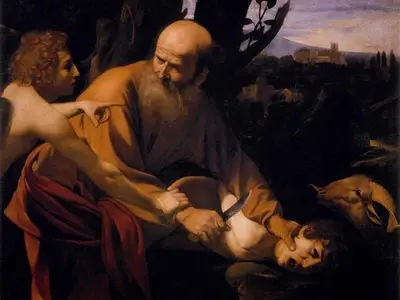Title of Artwork: “Sacrifice of Isaac”


Artwork by Caravaggio
Year Created 1602
Summary of Sacrifice of Isaac
Two paintings representing Isaac’s sacrifice, titled The Sacrifice of Isaac, date from the period between 1598 and 1603. Bartolomeo Cavarozzi, a renowned early follower of Caravaggio, may have created the works, but they could also be the work of the Italian painter Caravaggio (1571–1610), who is known to have visited Spain in 1617-1619.
All About Sacrifice of Isaac
Painting in Princeton’s Piasecka-Johnson Collection titled “The Sacrifice of Isaac,” believed to have been created in the early 16th century, dates back to a controversy about its authenticity.
When Caravaggio was in the Hospital of the Consolazione, he painted many works for the prior, who transported them back to Seville with him, according to Giulio Mancini, Caravaggio’s contemporary and an early biographer. Prior to the mid-1590s, the hospital had a Spanish ancestry. Although this would place the piece in the mid-1590s, Peter Robb, in his 1998 biography of Caravaggio, places it between 1598 and 1599 based on the sophistication of the painting.
A similarity between the Isaac model and the John the Baptist model currently on display in Toledo Cathedral’s museum implies that they should be viewed as a single figure. As crucial as it is to know that Caravaggio’s works were in Spain at an early date, there is significant evidence that they were painted by Bartolomeo Cavarozzi, an early follower who was in Spain between 1617 and 1619 and was a remarkable artist in his own right.
When Abraham was about to sacrifice his son Isaac in response to God’s order, an angel intervened and offered him a ram in Isaac’s place, delaying the process. Caravaggio’s dramatic chiaroscuro (tenebrism) illuminates the scene, casting a spotlight on the young angel’s face while the shadows cast by Abraham and Isaac reveal their intense emotions.
The angel’s hand rests on the ram’s head in imitation of Abraham’s left hand resting on Isaac’s head, the Patriarch’s other son. As God’s promise is fulfilled, we see only the three figures and the ram, with nothing to detract from the intense psychological drama unfolding.
The Uffizi Gallery, Florence, houses the second Sacrifice of Isaac. In 1603 and 1604 the future Pope Urban VIII paid Caravaggio a total of 100 scudi for a painting of this subject commissioned by Cardinal Maffeo Barberini, according to the early biographer Giovanni Bellori.
Portrait of Maffeo Barberini by Caravaggio, painted earlier, had apparently impressed the cardinal sufficiently for him to commission this second painting by the artist.
A man named Cecco Boneri has been identified as Isaac. Boneri modelled for Caravaggio on a number of occasions. According to new X-ray evidence, Caravaggio employed Cecco to create the angel as well, although he later changed the profile and hairstyle to obscure the likeness.
Information Citations
En.wikipedia.org, https://en.wikipedia.org/.

























